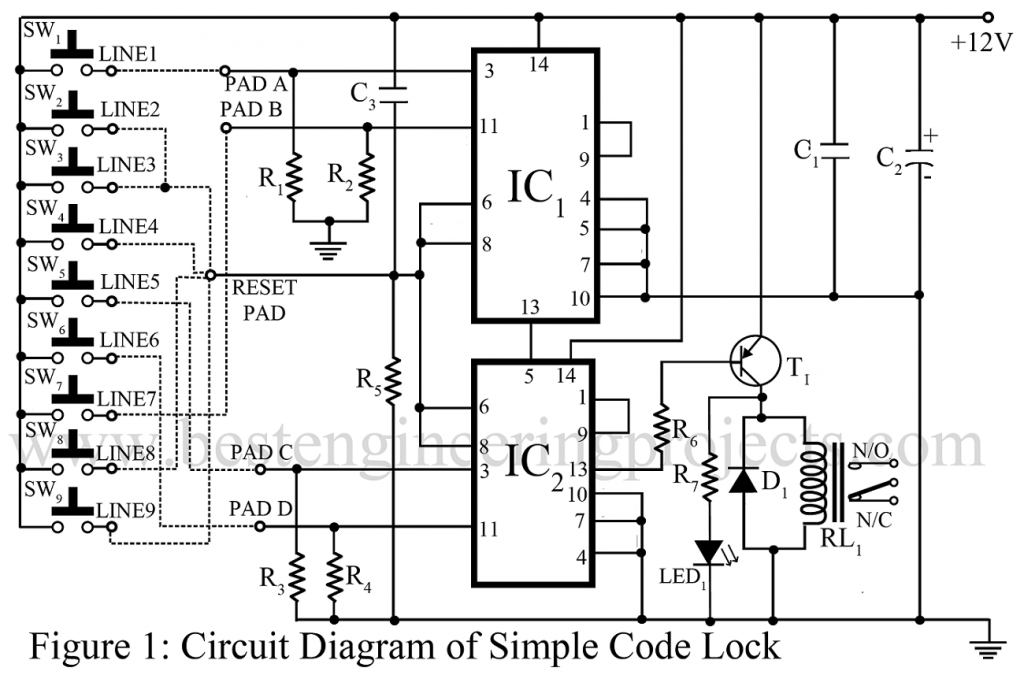Using codes for security has been a popular trend recently. A similar type of electronic project is presented right below called the electronic code lock circuit which ensures the use of four digits in the code locking process and these codes are keyed in remotely. The code can be unlocked easily by pressing the right keys and if someone presses the wrong keys, it resets the lock automatically. The complete phenomenon of the electronic code lock systems has been described briefly in the further paragraph.
Description and Working of Electronic Code Lock Circuit
In the circuit electronic code lock, the lock code is set through the proper connection of line wires to the pads A, B, C, and D as shown in the schematic diagram of the electronic code lock circuit. For clear understanding, an example might be more appealing. If the code is 1234, connect line 1 to A, line 2 to B, line 3 to C, line 4 to D, and the rest of the lines, 6, 7, 8, and 9 are connected to the reset pad as shown by the dotted lines in the respective circuit diagram.
The whole circuit of the electronic code lock is built around two CD4013 (IC1 and IC2) dual-D flip-flop ICs. The clock pins of the four flip-flops are directly connected to A, B, C, and D-pads in the circuit. The condition for energization of relay RL1 in the circuit is realized by clocking points A, B, C, and D in that order.
The remaining five switches as mentioned in the example are connected to the reset pad so that all the flip flops are reset. If the keypad switch (A/B/C/D) is touched, the clock input pin is briefly pulled high. As a result, the state of the flip-flop is altered. The output pin of each flip-flop designated as in the circuit diagram is wired to the input pin of the next flip-flop designated as D, whereas the D pin of the first flip-flop is connected to the ground.
If the correct sequence of pressing keys is followed, then a low level appears at the output of IC2. Then the relay is energized through the relay driver transistor. The reset keys of the circuit are wired to set pins 6 and 8 of each IC. (Power-on-reset capacitor C1 has been added at BEP lab during testing as the state of output is indeterminate during switching on operation).
This electronic code lock electric circuit can be implemented in multiple security applications. We can set the circuit code lock in cars and make sure the car starts only when the correct code sequence is pressed via the keypad. This circuit is sure to boost the security system. It can be used in other multiple areas where security plays a vital role.
Check out other security-related project posted on bestengineeringproject.com
- Car Lock System using Arduino and GSM
- Arduino Fingerprint Sensor Lock
- Arduino and RFID based Door Access System
- Light operated internal door latch
- RFID Based Security System Using Microcontroller AT89C52
PARTS LIST OF ELECTRONIC CODE LOCK CIRCUIT
| Resistor (all ¼-watt, ± 5% Carbon) |
| R1 – R5 = 4.7 MΩ
R6 = 18 KΩ R7 = 1 KΩ |
| Capacitors |
| C1 = 100 nF (Ceramic Disc)
C2 = 220 µF, 25V (Electrolytic Capacitor) C3 = 0.1 µF (Ceramic Disc) |
| Semiconductors |
| IC1, IC2 = CD4013b (Dual D-Type Flip Flip IC)
T1 = BC557 (General Purpose silicon PNP Transistor) D1 = 1N4001 (Rectifier Diode) LED1 = Any color LED |
| Miscellaneous |
| RL1 = 12V, 150Ω SPDT relay
SW1 – SW9 = Push to on switch key pad |
